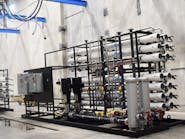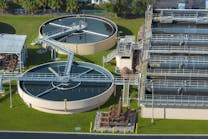Q: What is probably the most significant single contributor to public health in the last century?
A: Chlorine disinfection for water and food sanitation.
Introduction
Chlorine in some form is the most widely used disinfection medium for drinking water, wastewater and foods, and is also commonly used in swimming pools, cooling water systems and surface sanitizing. It is applied as gaseous chlorine, sodium and calcium hypochlorites, monochloramine, chlorinated isocyanurates or chlorine dioxide. It was introduced into drinking water treatment in the first decade of the 20th century and resulted in immediate reductions of waterborne diseases. Drinking water treatment and chlorine chemistry are also important in the food context because chlorinated drinking water or more highly chlorinated water is frequently used as a vehicle for food sanitation. So, we are commonly exposed to a variety of chlorine related chemicals and the question is: Are there risks, and if so, what is the risk-benefit cost balance?
Drinking water usage
The first continuous application of chlorine for drinking water in the U.S. was in Jersey City, New Jersey, in 1908 as calcium hypochlorite. The city’s typhoid fever death rate in 1895 was 80 per 100,000. They had switched to an alternate supply in 1906 and the rate was 21.4 per 100,000. After chlorination was initiated the typhoid fever rates again declined dramatically. A few days prior to the Jersey City initiation, the Chicago stockyards began to chlorinate animal feed water to improve the animals’ health and weight gain. Within a decade basically every large water supplier in the U.S. was chlorinating its drinking water and by 1936, typhoid fever was essentially eradicated.
Manufacturing
Electrolysis of sodium chloride brine solution gives chlorine gas and sodium hydroxide, so it is inexpensive to produce. Hypochlorite is made by combining the chlorine with sodium hydroxide in solution. It is provided to water plants in about 15 percent solution and as laundry bleach in about five percent solution. Chloramines are produced on-site by reacting hypochlorite with ammonia or ammonium salts. Chlorine dioxide is a gas that is made by reacting sodium chlorite with chlorine, or sodium chlorate with hydrochloric acid. It is unstable and explosive and it is made on-site for use without storage.
Chlorine chemistry
Chlorine is a manufactured chemical but natural chlorination processes also occur, e.g., on the oceans by solar photochemistry. Chlorine is very reactive and it can engage in numerous chemical processes under mild conditions. It is both an oxidizing and halogenating agent. Oxidation is probably the predominant chemical process occurring in chlorine’s water and food contact applications. Chlorinated organic disinfection byproducts (DBPs) are more easily detected at lower concentrations, so we tend to focus on them. Some DBPs have potential theoretical risks of long-term exposures at low concentrations, whereas the oxidized product alcohols, aldehydes, ketones and carboxylic acid byproducts are considered not to be unique in our oxygenated environment. Chlorine also spontaneously produces several inorganic byproducts in addition to hypochlorite and monochloramine, including chlorite, chlorate and perchlorate, and ultimately chloride. Bromate and bromated DBPs are produced indirectly if bromine is present in the brine or drinking water.
Chlorine disinfection
Chlorine species are generally excellent microbial disinfectants that function by fundamental chemical halogenation and/or oxidation processes at the cell surface or on the cellular DNA, so it is unlikely that many pathogenic microbes can evolve to become resistant to them as they have to many antibiotics. As far as we know, all bacteria and viruses as well as many protozoa are vulnerable to chlorine disinfection at least to some extent. Cryptosporidium protozoa are notably highly resistant to chlorine disinfection but not to chlorine dioxide.
Disinfectant dosages and residuals range from a fraction to several mg/l in finished water depending upon the treatment purpose and the disinfectant demand of the water. Disinfection CT (concentration in mg/l X time in minutes) values for 4 logs (99.99 percent) reduction at 10o C and neutral to slightly basic pH are: Chlorine, six; monochloramine, 1,491; and chlorine dioxide, 25. Chlorine’s efficacy is reduced as pH becomes more basic because more is converted from hypochlorous acid to the hypochlorite form. Chlorine dioxide is not affected by pH in the range of four to 10. Monochloramine is significantly less effective, but it has applications as a secondary disinfectant to reduce microbial regrowth during water storage and distribution. However, it is very effective for legionella control in plumbing because of its persistence, low chemical reactivity and being somewhat hydrophobic, as well as its likely ability to penetrate biofilms.
Taste and odor
Taste and odor detection and objection thresholds are somewhat subjective. Average taste thresholds, but not necessarily objectionable concentrations of free residual chlorine, increased from 0.075 mg/l to 0.450 mg/l as the pH increased from 5.0 to 9.0 in one taste panel study. The average taste threshold was 0.156 mg/l, with a range of 0.02 to 0.29 mg/l at pH 7.0. Those data indicate that taste sensitivity is greater for hypochlorous acid than for hypochlorite ion. Chlorine dioxide detections are in the range of 0.2 mg/l to 0.4 mg/l. Monochloramine taste detection is reported to range from about 0.4 mg/l to 0.6 mg/l, but it is not objectionable up to perhaps 3 mg/l.
Drinking water regulations
Surface waters are required to be filtered and disinfected and at-risk groundwaters are required to be disinfected. Both chlorine and chloramine have Maximum Residual Disinfection Levels (MRDLs) of 4 mg/l. Chlorine dioxide’s MRDL is 0.8 mg/l. These are nominally health-based values, but are doubtful because these substances rapidly decompose in the presence of reducing conditions as in saliva and in stomach acidity. Chlorite is regulated with an MCL of 1 mg/l but it is also chemically reactive when acidified. WHO’s drinking water guideline for chlorate is 0.7 mg/l, but it is not very reactive under gastrointestinal conditions.
Perchlorate is virtually nonreactive and excreted unchanged with a half-life of about eight hours. It currently has a drinking water health advisory of 15 parts per billion (ppb). Chlorate and perchlorate are under active regulatory consideration by EPA and there will likely be regulatory proposals in the near future. Bromate is regulated at 0.010 mg/l. Trihalomethanes (THMs) (0.080 mg/l) and haloacetic acids (0.060 mg/l) have been regulated for 20 to 35 years. The THMs and especially chloroform are no longer generally considered to be carcinogenic risks in drinking water, but rather indicator chemicals.
Organic disinfection byproducts
Several hundred individual chlorination DBPs have been identified at ppb, but mostly at parts per trillion (ppt) levels in various drinking waters. The aggregated total quantity of DBPs range from a few micrograms per liter to a fraction of a milligram per liter in some waters with high levels of natural precursors, depending upon the chlorine dosage, quantity of precursors, pH, temperature and contact time. Chloramines rapidly form from ammonia and they are poor halogenating and oxidizing agents, so ammonia will suppress the formation of most of the halogenated and oxidized DBPs but produce some others. Chlorine dioxide does not directly produce halogenated DBPs, but rather oxidized DBPs, e.g., alcohols and aldehydes.
Despite theoretical concerns about DBPs that led to their regulation and/or WHO guidelines, the issue of potential significant health concerns has been controversial. Epidemiology studies have sometimes indicated potential small incremental cancer risks from long-term chlorinated drinking water consumption; however, other studies have suggested that the apparent risks may actually be due to inadequate water consumption. Bladder cancers are most suspected, however, there are several common causes of bladder cancer, including smoking, so those background incidences cause difficulties in attributing small incremental risks to DBPs. In 2006, EPA concluded that no dose response or causal relationship existed between exposure to chlorinated drinking water or chlorinated disinfection byproducts, and adverse developmental or reproductive health effects.
The toxicology of numerous DBPs has been studied extensively for more than 30 years; however, the number of byproducts is so large and their individual concentrations are so low that it is questionable whether there is value in examining many of them in detail. One study applied structure-activity techniques and genotoxicity data as a prescreening ranking for carcinogenic potential from long-term exposure. Only 20 of 209 DBPs were of priority concern with moderate (17) or high-moderate ratings (three). The three high-moderate chemicals are known to be rapidly detoxified and hypothetical risk calculations were at two per 1,000,000 upper-bound lifetime risk.
Conclusions
Chlorine disinfection has been recognized by health and international agencies as one of the most significant public health benefits of the last century, and it will likely continue to be so. Chlorination would be the most effective measure to rapidly reduce waterborne disease risks in developing countries. Reported waterborne diseases have continued to decline in the U.S. since the Safe Drinking Water Act implementation in about 1980. It is almost fortuitous serendipity that chlorine disinfection is so effective, so simple to apply and so inexpensive. It has been stated that in addition to huge morbidity reductions, clean water has been responsible for nearly half of the total mortality reduction in major cities from the late 19th and early 20th centuries, three-quarters of the infant mortality reduction and nearly two-thirds of the child mortality reductions that have occurred. Excess chlorine species can contribute taste to drinking water, but that is readily eliminated by an inexpensive carbon tap filter. Risks of DBPs are still in debate, but are likely very small, if at all. The risk-benefit costs balance is strongly in favor of water chlorination. WHO continues to advise that disinfection byproducts should never be a reason (or excuse) for reducing disinfection of drinking water.
Dr. Cotruvo is president of Joseph Cotruvo and Associates, LLC, Water, Environment and Public Health Consultants. He is a former director of the U.S. EPA Drinking Water Standards Division.


